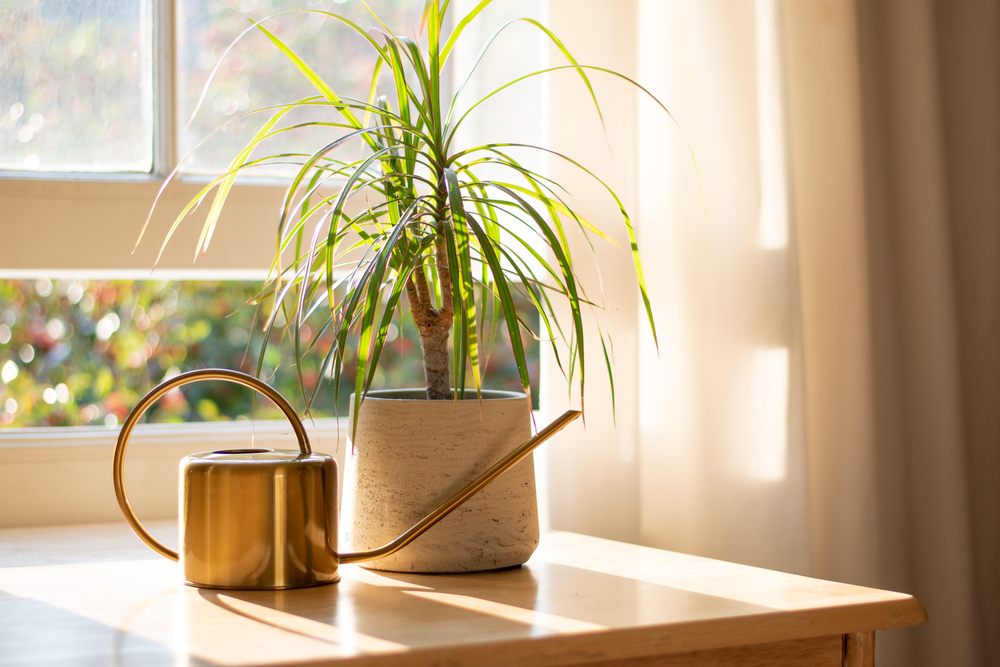When winter hits and you can’t grow your beautiful outdoor plants anymore, indoor plants come to the rescue. House plants have plenty of health benefits, and they can even improve your mood. If you’re still in the process of designing your indoor greenery, we recommend including a dragon tree. It can thrive indoors (and even outdoors in regions where the temperatures stay warm all year round). For those in chillier climates, keep your dragon tree happy and healthy indoors with these few tips, and enjoy its beauty for years to come.

Benefits of having a dragon tree indoors
Elegant appearance
The signature look of the dragon tree resembles that of a tiny palm tree. Its leaves are long and spiky, giving a chic and elegant appearance that matches any decor in the house.
Air purification
Not only is the dragon tree beautiful, but it’s also beneficial to your health since it’s one of the best air purifiers among indoor plants. Through the process of photosynthesis, this plant can clean the air in your home and rid it of toxins, removing harmful chemicals and allergens from the air.
Easy care
One of the easiest indoor plants out there, dragon trees are tough and resilient, and they can survive in a variety of light conditions.
How do you take care of a dragon tree?
Gardening novices, rejoice: A dragon tree is an easy indoor plant to care for. While problems can arise, they are uncommon, and keeping up with a dragon tree’s care schedule is very simple.
Does a dragon tree need sunlight?
While dragon trees prefer bright light conditions, they don’t need bright light to survive, and they’ll fare well in even low light conditions. Be sure the plant isn’t in direct sunlight for too long so that the leaves don’t scorch.
How often do you need to water a dragon tree?
Since dragon trees like their soil to completely dry out between watering sessions, you only need to water it once per week, or even less during colder months. Just make sure you give it a good soak and keep it in a pot that drains well.
Do you need to fertilize?
Dragon trees are slow growers, but they will continue to grow for years and years if their pot is big enough. In fact, they can reach up to a height of eight feet indoors. Fertilizing your plant in the spring and summer promotes growth and keeps your dragon tree at peak health, so be sure to give it some indoor plant food once or twice a month during those seasons.
When should you repot your dragon tree?
Since they grow slowly, you only need to repot dragon trees every 2-3 years to add some new soil to the mix. You may need to repot your dragon tree sooner if it is showing signs of root rot or being root-bound.
Root rot: If you suspect root rot, move the plant into a pot that has better drainage and replace the soil.
Root-bound: If the plant is root bound, you’ll notice roots coming out of the drainage holes at the bottom of the pot, indicating that the root system has become too big for its pot. If that’s the case, transfer it to a bigger pot.

Dragon tree care: Common issues
While dragon trees are both gorgeous and easy to maintain, it’s possible that problems may arise as they grow. Here are some issues to watch out for.
Excess loss of leaves
Dragon trees typically lose some of their leaves, and it’s not uncommon to find a few fallen leaves around the plant’s base. As new leaves grow in, older leaves wilt and fall off — that’s a natural part of the growth process for dragon trees. If your plant is losing an unusual amount of leaves, so much that it’s starting to look bare, the plant is in distress. This is typically due to over or under watering, so be sure to check your watering schedule for the plant.
Drooping leaves
If your dragon tree’s leaves appear to be drooping downward, this may be another sign of improper watering. If it’s likely that you’re underwatering, a good soak will give the plant what it needs for its leaves to perk up in a day or so. Overwatering, however, can cause root rot if the pot doesn’t have good drainage. This rot can cause the leaves to droop as the roots start struggling to get nutrients to the rest of the plant.
Browning leaves
If those spiky green leaves on your dragon plant start to turn brown, the issue might be the temperature in the room. If the plant is in an area that has extreme or often fluctuating temperatures, the plant can become stressed and stop carrying nutrients to its leaves. Another culprit may be too much direct sunlight, as this will burn the leaves and make them wilt as well.
Caring for indoor plants is rewarding, particularly in colder months when vegetation outdoors is sparse in some regions. We encourage you to fill your home with plants of all shapes, sizes, and colors but make sure you leave room for a dragon tree or two.



